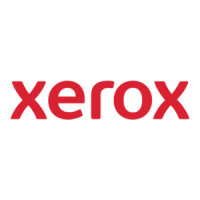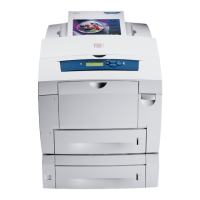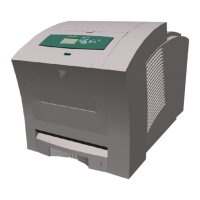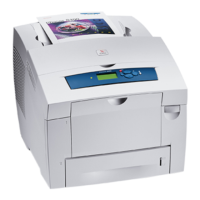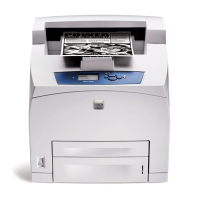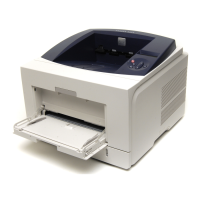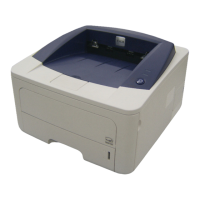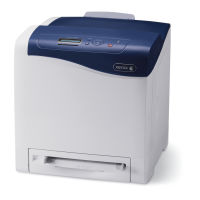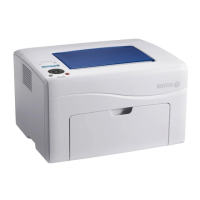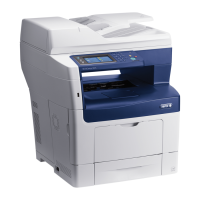








Do you have a question about the Xerox Phaser 8560 and is the answer not in the manual?
Defines terms and symbols used in the manual for clarity and safety.
Lists and defines common abbreviations used throughout the service manual.
Explains the meaning and importance of notes, cautions, and warnings in procedures.
Defines specific terminology related to the printer's components and functions.
Details power requirements, voltage specifications, and grounding procedures.
Provides procedures for safely disconnecting the printer from its power source.
Provides overarching safety instructions for performing service on the printer.
Emphasizes the importance of recognizing and adhering to all posted warning labels.
Explains the function and verification of safety interlock switches.
Safety procedures specific to working with the printer's electrical parts.
FCC compliance information for the device in the US.
Compliance information pertaining to Canadian regulatory standards.
Overview of troubleshooting strategies involving control panel error messages and codes.
Identifies errors and LED codes displayed during the printer's startup sequence.
Explains Built-In Self Test failures and their associated blink patterns.
Details Power-On Self Test errors and how they are reported via LEDs and messages.
Methods for diagnosing and resolving issues indicated by specific fault codes.
General approach to troubleshooting printer issues not covered by specific error codes.
Procedures for utilizing built-in service diagnostic tests to verify component function.
Troubleshooting common electrical issues and component failures within the printer.
Diagnosing and resolving issues related to paper handling, jams, and media feeding.
Troubleshooting common issues related to printer network connectivity and communication.
General guide to identifying various print quality issues like streaks, smudges, and poor color.
Instructions on how to interpret results from diagnostic print tests for fault isolation.
Covers common print defects such as lines, marks, fuzzy text, and image transfer issues.
Procedures for setting component home positions for correct operation.
Instructions on how to enable or disable the jet substitution feature.
Step-by-step guide for resetting the printer's Non-Volatile Random Access Memory.
Detailed step-by-step instructions for performing cleaning maintenance tasks.
Covers common maintenance activities like drum cleaning, waste tray, and lubrication.
Procedures for removing the printer's external covers and panels.
Steps for disassembling key components within the printer's imaging system.
Procedures for disassembling parts related to the paper transport system.
Steps for removing and replacing motors, gears, solenoids, and clutches.
Procedures for disassembling the main electronic modules and boards.
A guide on how to navigate and utilize the provided parts lists effectively.
Organizes parts into logical sections such as covers, imaging, and electronics.
Displays the primary wiring connections and layout for the printer.
Covers wiring configurations for different sections of the printer.
Illustrations showing the printer's menu structure for navigation.
Useful checklists to aid in diagnosing and resolving common printer issues.
Offers a general introduction to the printer and its capabilities.
Details the various configurations and options available for the printer.
Information on setting up and managing the printer's control panel features.
Lists the key technical specifications, dimensions, and environmental requirements.
Overview of troubleshooting strategies involving control panel error messages and codes.
How to check printer status, usage statistics, and historical error data.
Description of the Built-In Self Test and its error reporting methods.
Description of the Power-On Self Test and its error reporting.
Description of the Print Engine Self Test and its error reporting.
Explains Built-In Self Test failures and their associated blink patterns.
Table defining Power-On Self Test error blink patterns for diagnostics.
Lists common POST error codes and their corresponding descriptions and troubleshooting steps.
Step-by-step instructions for safely removing the ink loader assembly from the printer.
Procedures for removing the Y-axis belt, tension spring, and motor.
Detailed steps for removing the Y-axis motor assembly from its mounting bracket.
Instructions for removing the left and right printhead restraints.
Procedures for accessing and disconnecting the purge pump and bias spring hook.
Steps for removing printhead restraints and the roll block assembly.
Defines terms and symbols used in the manual for clarity and safety.
Lists and defines common abbreviations used throughout the service manual.
Explains the meaning and importance of notes, cautions, and warnings in procedures.
Defines specific terminology related to the printer's components and functions.
Details power requirements, voltage specifications, and grounding procedures.
Provides procedures for safely disconnecting the printer from its power source.
Provides overarching safety instructions for performing service on the printer.
Emphasizes the importance of recognizing and adhering to all posted warning labels.
Explains the function and verification of safety interlock switches.
Safety procedures specific to working with the printer's electrical parts.
FCC compliance information for the device in the US.
Compliance information pertaining to Canadian regulatory standards.
Overview of troubleshooting strategies involving control panel error messages and codes.
Identifies errors and LED codes displayed during the printer's startup sequence.
Explains Built-In Self Test failures and their associated blink patterns.
Details Power-On Self Test errors and how they are reported via LEDs and messages.
Methods for diagnosing and resolving issues indicated by specific fault codes.
General approach to troubleshooting printer issues not covered by specific error codes.
Procedures for utilizing built-in service diagnostic tests to verify component function.
Troubleshooting common electrical issues and component failures within the printer.
Diagnosing and resolving issues related to paper handling, jams, and media feeding.
Troubleshooting common issues related to printer network connectivity and communication.
General guide to identifying various print quality issues like streaks, smudges, and poor color.
Instructions on how to interpret results from diagnostic print tests for fault isolation.
Covers common print defects such as lines, marks, fuzzy text, and image transfer issues.
Procedures for setting component home positions for correct operation.
Instructions on how to enable or disable the jet substitution feature.
Step-by-step guide for resetting the printer's Non-Volatile Random Access Memory.
Detailed step-by-step instructions for performing cleaning maintenance tasks.
Covers common maintenance activities like drum cleaning, waste tray, and lubrication.
Procedures for removing the printer's external covers and panels.
Steps for disassembling key components within the printer's imaging system.
Procedures for disassembling parts related to the paper transport system.
Steps for removing and replacing motors, gears, solenoids, and clutches.
Procedures for disassembling the main electronic modules and boards.
A guide on how to navigate and utilize the provided parts lists effectively.
Organizes parts into logical sections such as covers, imaging, and electronics.
Displays the primary wiring connections and layout for the printer.
Covers wiring configurations for different sections of the printer.
Illustrations showing the printer's menu structure for navigation.
Useful checklists to aid in diagnosing and resolving common printer issues.
Offers a general introduction to the printer and its capabilities.
Details the various configurations and options available for the printer.
Information on setting up and managing the printer's control panel features.
Lists the key technical specifications, dimensions, and environmental requirements.
Overview of troubleshooting strategies involving control panel error messages and codes.
How to check printer status, usage statistics, and historical error data.
Description of the Built-In Self Test and its error reporting methods.
Description of the Power-On Self Test and its error reporting.
Description of the Print Engine Self Test and its error reporting.
Explains Built-In Self Test failures and their associated blink patterns.
Table defining Power-On Self Test error blink patterns for diagnostics.
Lists common POST error codes and their corresponding descriptions and troubleshooting steps.
Step-by-step instructions for safely removing the ink loader assembly from the printer.
Procedures for removing the Y-axis belt, tension spring, and motor.
Detailed steps for removing the Y-axis motor assembly from its mounting bracket.
Instructions for removing the left and right printhead restraints.
Procedures for accessing and disconnecting the purge pump and bias spring hook.
Steps for removing printhead restraints and the roll block assembly.
| Color | Yes |
|---|---|
| Duplex printing | No |
| Print technology | Laser |
| Maximum resolution | 2400 x 600 DPI |
| Time to first page (color, normal) | 5 s |
| Print speed (black, normal quality, A4/US Letter) | 3 ppm |
| Print speed (color, normal quality, A4/US Letter) | 30 ppm |
| Maximum internal memory | 1 MB |
| Sound power level (standby) | 33 dB |
| Sound pressure level (printing) | 54 dB |
| Maximum duty cycle | 85000 pages per month |
| Number of print cartridges | 4 |
| Page description languages | PCL 5c |
| Maximum input capacity | 625 sheets |
| Paper tray 2 input capacity | 525 sheets |
| Multi-Purpose tray input capacity | 100 sheets |
| Power requirements | 110 - 240 V, 50/60 Hz |
| Networking features | 10/100BaseTX |
| Standard media sizes | 140 x 216 mm - 216 x 356 mm |
| Power consumption (active) | 230 W |
| Compatible operating systems | Linux, Mac OS X 10.2 +, Novell NetWare 3.x +, Windows 2000 + |
| Envelopes sizes | C5, DL |
| Maximum print size | 216 x 356 mm |
| Paper tray media types | Bond paper, Envelopes, Glossy paper, Labels, Plain paper, Recycled paper, Transparencies |
| Non-ISO print media sizes | Executive (184 x 267mm), Legal (media size), Letter (media size), Statement (140 x 216mm) |
| ISO A-series sizes (A0...A9) | A4, A5, A6 |
| ISO B-series sizes (B0...B9) | B5 |
| Maximum ISO A-series paper size | A4 |
| Supported network protocols (IPv4) | IPv6 |
| Sustainability certificates | ENERGY STAR |
| Power consumption (PowerSave) | 43 W |
| Storage temperature (T-T) | -30 - 60 °C |
| Operating temperature (T-T) | 10 - 32 °C |
| Storage relative humidity (H-H) | 10 - 95 % |
| Operating relative humidity (H-H) | 10 - 80 % |
| Dimensions (WxDxH) | 406 x 533.4 x 368 mm |
|---|
